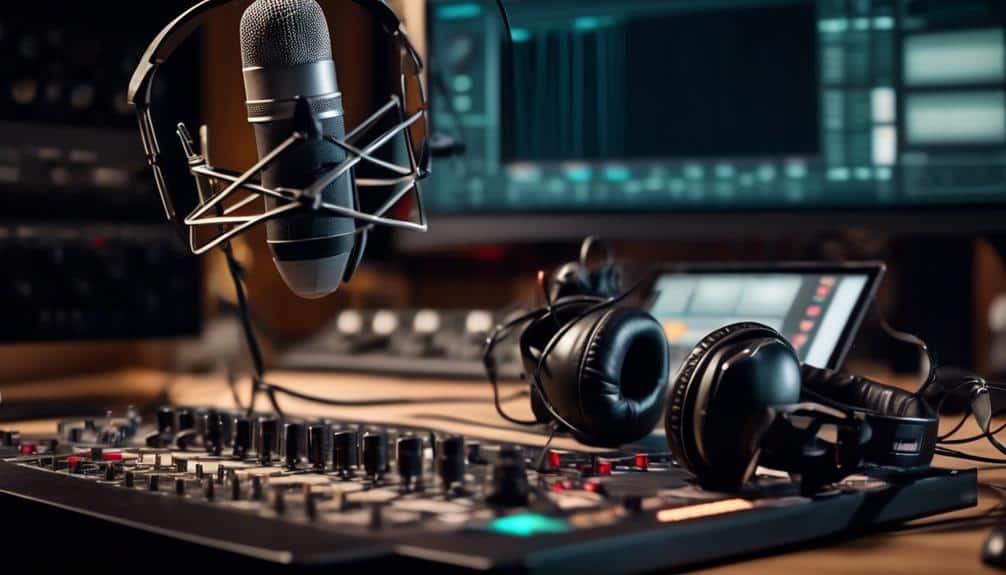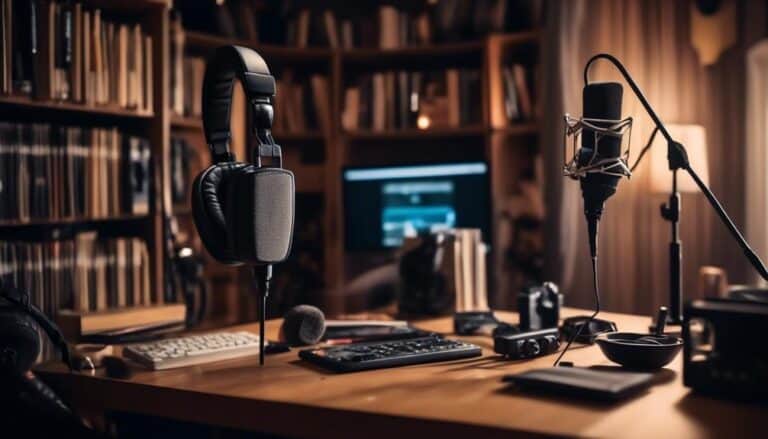Soundscaping Your Podcast: How to Use Music and Sound Effects Effectively
When it comes to crafting your podcast, think of sound as the paintbrush that colors your content. Music and sound effects can elevate your message, setting the tone and enhancing the listener's experience.
But how do you ensure that these elements blend seamlessly without overpowering your narrative? Let's explore the art of soundscaping your podcast to create a captivating auditory journey that keeps your audience engaged and wanting more.
Key Takeaways
- Select music that aligns with the mood and tone of your podcast to set the atmosphere effectively.
- Use sound effects strategically to enhance storytelling by adding depth and realism to key moments.
- Experiment with seamless transitions using subtle sound effects for a captivating flow throughout your episodes.
- Maintain professional quality by balancing audio levels, mixing dialogue, music, and sound effects harmoniously for a polished listening experience.
Choosing the Right Soundtrack

When selecting the ideal soundtrack for your podcast, consider the mood and tone you aim to convey to your audience. The soundtrack selection plays a crucial role in setting the atmosphere of your podcast. To create an engaging listening experience, focus on mood creation through your music choices. Whether you want to evoke excitement, suspense, or tranquility, the right soundtrack can enhance the overall impact of your content.
Incorporating sound effects and transition techniques can further elevate your podcast. Sound effects can add depth and realism to your storytelling, immersing your audience in the narrative. Transition techniques such as fades, crossfades, or even strategic silence can help maintain a seamless flow between segments, keeping your listeners engaged from start to finish.
Experiment with different genres, tempos, and instruments to find the perfect soundtrack that aligns with the theme and message of your podcast. Remember, the soundtrack you choose should complement your content and enhance the emotional connection with your audience.
Setting the Mood With Music
Crafting the perfect ambiance with music is essential to engage your audience and enhance the overall listening experience of your podcast. To set the mood effectively, start by creating playlists that align with the theme or message of your episode. When creating playlists, consider exploring genres beyond your comfort zone. Experiment with different styles such as classical, electronic, or even ambient sounds to evoke specific emotions or convey particular atmospheres.
Dive into the world of music genres to find the perfect match for each segment of your podcast. For instance, upbeat and energetic tracks can inject enthusiasm into introductions or transitions, while gentle melodies can create a calming backdrop for reflective moments or interviews. By carefully selecting music that complements the content of your podcast, you can create a cohesive and immersive listening experience for your audience.
Incorporating Sound Effects

To elevate the auditory experience of your podcast further, consider integrating sound effects strategically to enhance storytelling and captivate your listeners. Incorporating sound effects can truly elevate the quality of your episodes and create a more immersive experience for your audience.
Here are four ways to effectively use sound effects in your podcast:
- Set the Scene: Use sound effects to transport your listeners to different locations or environments, enhancing the overall atmosphere of your storytelling.
- Highlight Key Moments: Employ sound effects to emphasize important moments in your narrative, adding depth and impact to the content of your episodes.
- Create Transitions: Smoothly transition between segments or scenes by using sound effects as a bridge, keeping your listeners engaged and enhancing the overall flow of your podcast.
- Enhance Emotions: Use sound effects to evoke emotions in your audience, whether it's suspense, joy, or excitement, adding a layer of depth to your storytelling and making your episodes more memorable.
Creating Seamless Transitions
Consider employing subtle sound effects at the end of each segment to smoothly transition between topics and maintain a cohesive flow throughout your podcast. Transition techniques play a crucial role in keeping your audience engaged and ensuring a seamless listening experience.
One effective method is to use transitional sound effects that act as auditory cues, signaling the shift from one topic to the next. These can range from subtle musical motifs to ambient sounds that evoke the upcoming theme. Seamless blending is key; the goal is to create a natural progression that guides your listeners from one segment to another without abrupt interruptions.
To achieve this, experiment with fade-ins and fade-outs, where the sound gradually increases or decreases in volume, gently guiding the listener's attention. Another technique is to overlap the sound effects from the ending segment with the beginning of the next, creating a smooth transition between topics. By mastering these transition techniques, you can elevate the overall listening experience and maintain a captivating flow throughout your podcast.
Balancing Audio Levels

Achieving optimal audio levels in your podcast requires a meticulous balance of sound elements to ensure a professional and polished listening experience. When working on balancing audio levels, keep these key points in mind:
- Volume Control: Utilize volume control to adjust the loudness of different tracks, ensuring that no element overpowers the others.
- Equalizing Levels: Equalize levels by adjusting the volume of individual tracks to maintain a consistent sound throughout the podcast.
- Sound Mixing: Skillfully mix various audio elements such as dialogue, music, and sound effects to create a harmonious blend that enhances the overall listening experience.
- Monitoring Tools: Make use of monitoring tools like audio meters or headphones to accurately gauge and fine-tune the audio levels for a balanced and professional result.
Frequently Asked Questions
How Can I Legally Use Copyrighted Music in My Podcast Without Facing Copyright Infringement Issues?
To legally use copyrighted music in your podcast without facing infringement, explore fair use guidelines, acquire proper licensing, or opt for Creative Commons or royalty-free tracks. These options provide flexibility while respecting copyright laws.
Are There Any Specific Platforms or Resources Where I Can Find High-Quality Sound Effects for My Podcast?
Looking for high-quality sound effects for your podcast? Explore sound library options like Creative Commons for free resources. Enhance your episodes with audio editing tips and find the perfect sounds to captivate your audience.
What Are Some Common Mistakes to Avoid When Incorporating Music and Sound Effects Into a Podcast?
When adding music and sound effects to your podcast, avoid common pitfalls like overloading with noise, neglecting copyright laws, and using distracting or inappropriate sounds. Stick to best practices to enhance your content effectively.
How Can I Ensure That the Transitions Between Different Segments of My Podcast Flow Smoothly and Seamlessly?
To ensure seamless transitions and a smooth podcast flow, vary your segment endings with fade-outs, crossfades, or sound bridges. Use music or sound effects that complement each other and the overall theme. Keep the pacing consistent for a cohesive listening experience.
Are There Any Tools or Software That Can Help Me Balance Audio Levels and Improve the Overall Sound Quality of My Podcast?
To improve your podcast's sound quality, consider using audio editing tools for volume control. These tools can help balance audio levels and create a more polished final product. Experiment with different software to find what works best for you.
Conclusion
In conclusion, soundscaping your podcast with the right music and sound effects can greatly enhance the overall listening experience for your audience. By carefully selecting a soundtrack, setting the mood with music, incorporating sound effects, creating seamless transitions, and balancing audio levels, you can create a dynamic and engaging podcast that keeps listeners coming back for more.
So, take the time to craft a sonic landscape that captures the essence of your content and leaves a lasting impression on your audience.








